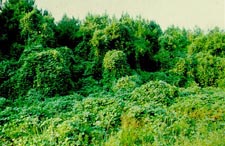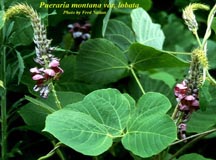| page last updated |
 |
River Tour | Estuary | Salt Marsh | |
| What is an Estuary? > Climate > Geology > Surface Water > Ground Water > Aquatic Habitat > Upland Habitat > Ecological Processes > Animals and Plants > Socioeconomic Values > Human Impacts and Pollution > Where does Your water come from? > Management Issues > Protecting YOUR Watershed | ||
|
K-12
Students Site
|
||
| Kudzu | |||||||
|
Kudzu is a leafy vine that was introduced to the southeast in the 1930's to prevent soil erosion. The good thing about Kudzu is that it grows like crazy. Its broad leaves and strong root system do a great job at preventing soil erosion. The bad thing about Kudzu is that it grows like crazy. During the summer, vines grow as much as a foot (0.3 meters) per day. Some people insist you can see it growing! This endless vine can cover entire roadsides, trees, telephone poles, barns, tractors, and even houses! During the Great Depression of 1930's, the government provided jobs to men to plant Kudzu all over the southeast. Kudzu prevents soil erosion, is edible, and cut Kudzu can be fed to goats and cattle. Today, however, the government provides jobs to people to get rid of Kudzu. The problem with Kudzu is that it kills surrounding plants. It grows over them, completely covers them, and blocks sunlight from them (preventing photosynthesis). The weight of Kudzu smothering plants also can kill them (Kudzu can even pull down trees!). Kudzu grows better here than in its native countries of China and Japan. One reason is a lack of natural predators. When Kudzu was first brought to America, the insects (native to China and Japan) that eat and damage Kudzu were not brought too. Researchers are now studying ways to limit the growth of Kudzu with biological controls, such as herbivorous insects. To learn more about kudzu, visit these links: |
 |
||||||
 |
|||||||
 |
|||||||